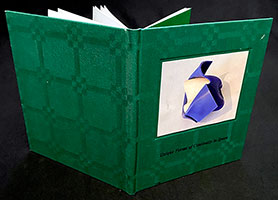
Unique Forms of Continuity in Space
A sequence by Maud Cotter with text by Simon Cutts
Clonmel, Tipperary, Ireland: Coracle, 2020. Edition of 200.
36 pages; 17.5 x 15 cm. Casebound picnic paper over boards, with embossed cover image. Seven tipped-in images of the series and a facsimile of the 20 cent euro coin holding an image of the futurist piece. Numbered.
Coracle: "A collaboration surrounding Maud Cotter's altered hot water bottle sculptures, referring in turn to the dynamic of Boccioni's work of the same title."
Excerpts: "The 1913 sculpture Unique Forms of Continuity in Space by the Futurist Umberto Boccioni ... borrows from that Hellenistic sculpture of Nike … It is also perhaps in the same vein that the images of split hot water bottles with burgeoning plaster insets run parallel to the products of a sports and shoe company named after the Greek goddess herself. In the manner of such stylistically improbable pairings, initiated by the futurists with their manifesto, why not also these reconstructed hot-water bottles of Maud Cotter becoming pillows and purses, and which at their source and to this day are still called 'mezzo-maritos- in Italy - half-husbands!"
End note: "The seven works illustrated here are taken from the set of 12 bottles made as a single work under that title."
www.smarthistory.org: ”Unique Forms appears on the Italian 20-cent Euro coin and is both Futurism’s most famous symbol and a reminder that the movement itself was dynamic and did not always follow its own declarations. The Futurists sought to clear away the legacy of art’s history so that the future could come more quickly, but Unique Forms has often been compared to the ancient Greek Nike of Samothrace and Gian Lorenzo Bernini’s Apollo and Daphne. The Futurists wanted to destroy the museums, but in the end, their work was added to the canon of Italian sculpture.”
(SOLD)